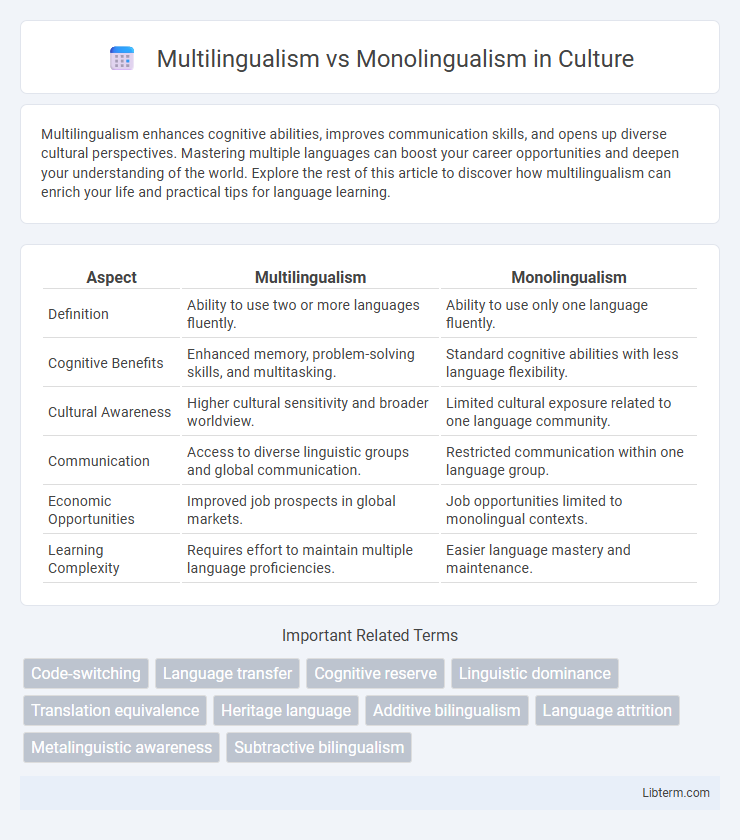Multilingualism enhances cognitive abilities, improves communication skills, and opens up diverse cultural perspectives. Mastering multiple languages can boost your career opportunities and deepen your understanding of the world. Explore the rest of this article to discover how multilingualism can enrich your life and practical tips for language learning.
Table of Comparison
| Aspect | Multilingualism | Monolingualism |
|---|---|---|
| Definition | Ability to use two or more languages fluently. | Ability to use only one language fluently. |
| Cognitive Benefits | Enhanced memory, problem-solving skills, and multitasking. | Standard cognitive abilities with less language flexibility. |
| Cultural Awareness | Higher cultural sensitivity and broader worldview. | Limited cultural exposure related to one language community. |
| Communication | Access to diverse linguistic groups and global communication. | Restricted communication within one language group. |
| Economic Opportunities | Improved job prospects in global markets. | Job opportunities limited to monolingual contexts. |
| Learning Complexity | Requires effort to maintain multiple language proficiencies. | Easier language mastery and maintenance. |
Defining Multilingualism and Monolingualism
Multilingualism is the ability of an individual or community to use and understand multiple languages proficiently, enabling communication across diverse linguistic groups. Monolingualism refers to the use or knowledge of only one language, limiting communication to a single linguistic context. The distinction impacts cognitive flexibility, cultural exposure, and social interaction in globalized environments.
Historical Perspectives on Language Acquisition
Historical perspectives on language acquisition highlight the dominance of monolingualism in early linguistic research, which emphasized single-language competence as the norm. Early theories often viewed multilingualism as a hindrance to cognitive development, contrasting with contemporary studies that recognize the cognitive benefits and social advantages of bilingual and multilingual individuals. Anthropological and sociolinguistic research now illustrates that multilingualism has been the historical norm in many societies, reflecting complex patterns of language contact, trade, and migration throughout human history.
Cognitive Benefits of Multilingualism
Multilingualism enhances cognitive flexibility by improving executive functions such as problem-solving, multitasking, and attention control. Research shows bilingual and multilingual individuals have increased gray matter density in brain regions associated with memory and decision-making. These cognitive benefits contribute to delayed onset of dementia and better overall mental agility compared to monolinguals.
Social Impacts of Being Monolingual
Monolingual individuals often face social limitations due to reduced communication opportunities in diverse, multilingual environments, impacting social integration and professional networking. The inability to engage in multiple languages can hinder cross-cultural understanding and limit participation in globalized communities. Social isolation and decreased cultural empathy are common consequences for those confined to a single language, affecting social cohesion.
Economic Advantages of Speaking Multiple Languages
Speaking multiple languages enhances global business opportunities, allowing individuals to access broader markets and foster stronger international partnerships. Bilingual and multilingual employees often command higher salaries and demonstrate greater cognitive flexibility, making them valuable assets in diverse industries. Multilingualism also improves cross-cultural communication, reducing misunderstandings and increasing efficiency in multinational companies.
Educational Approaches: Multilingual vs Monolingual
Educational approaches to multilingualism emphasize immersive language programs, promoting cognitive flexibility and cultural awareness by integrating multiple languages in the curriculum. Monolingual educational methods typically focus on deep mastery of a single language, aiming for proficiency and academic achievement within that linguistic framework. Research indicates that multilingual education enhances problem-solving skills and global competence, while monolingual approaches may streamline language instruction but limit cross-cultural communication opportunities.
Language and Cultural Identity
Multilingualism enriches cultural identity by enabling individuals to connect deeply with multiple heritage languages and their associated traditions, fostering a broader sense of belonging and intercultural understanding. Monolingualism often limits cultural identity to a single linguistic framework, which can restrict exposure to diverse worldviews and cultural expressions. Embracing multilingualism supports cognitive flexibility and reinforces the preservation of minority languages, strengthening cultural diversity globally.
Challenges in Multilingual Societies
Multilingual societies face challenges such as communication barriers, which can hinder social cohesion and access to public services. Educational systems often struggle to accommodate diverse languages, leading to disparities in learning outcomes and resource allocation. Policy-making complexity increases with the need to balance language rights and integration efforts, impacting social unity and economic development.
Technological Innovations and Language Learning
Technological innovations such as AI-powered language apps and real-time translation tools significantly enhance multilingual learning, enabling users to acquire multiple languages more efficiently than monolingual methods. Multilingual individuals benefit from adaptive algorithms that customize language practice, promoting faster proficiency and better retention. These advancements demonstrate a clear advantage of multilingualism in leveraging technology to expand communication capabilities and cultural understanding.
The Future of Multilingualism and Monolingualism
Multilingualism is projected to become increasingly vital as global interconnectedness expands, enhancing cognitive flexibility, cross-cultural communication, and economic opportunities. Monolingualism may face limitations in future job markets and social integration due to growing demand for diverse language skills in technology, international business, and diplomacy. Embracing multilingual education and language learning technologies will be crucial for adapting to the evolving linguistic landscape.
Multilingualism Infographic

 libterm.com
libterm.com